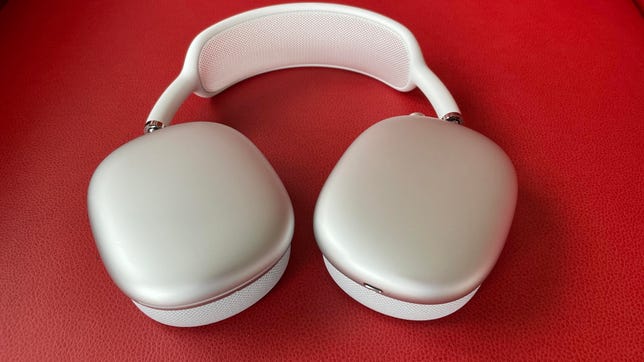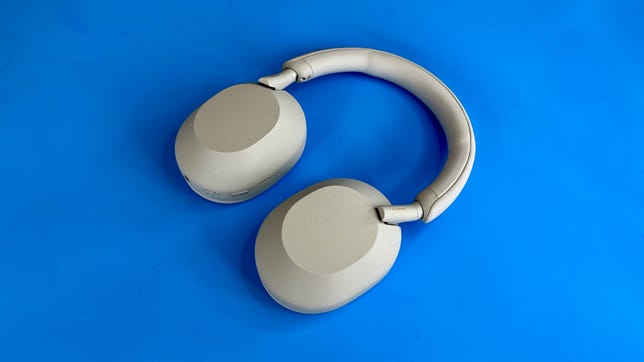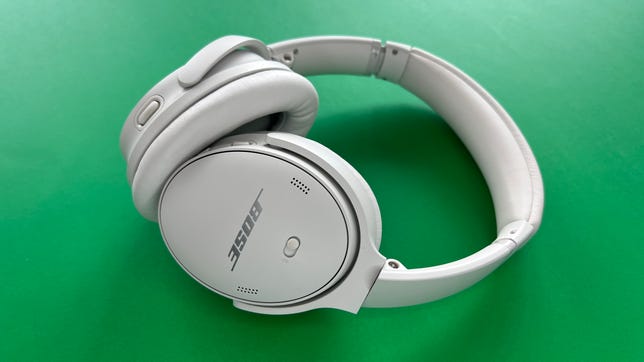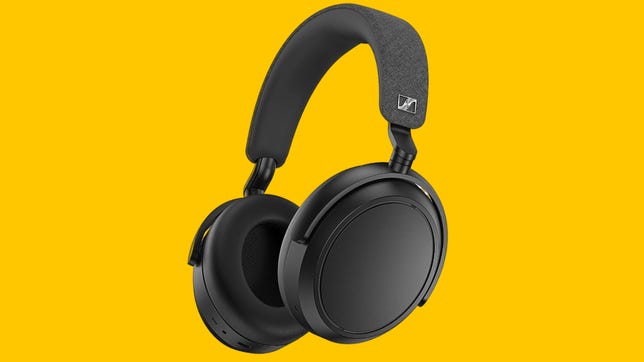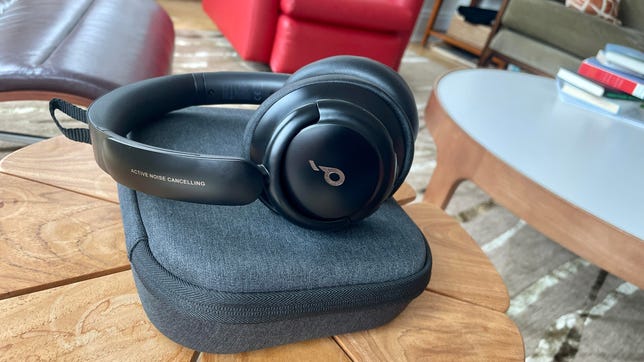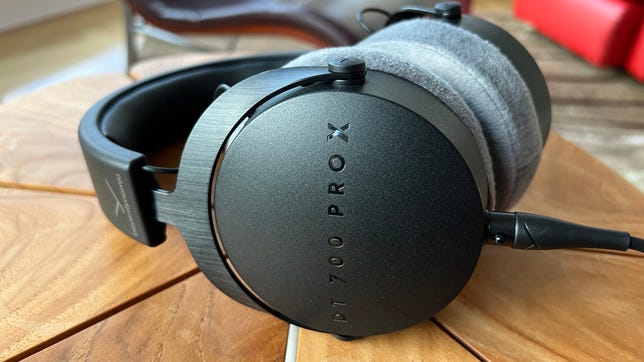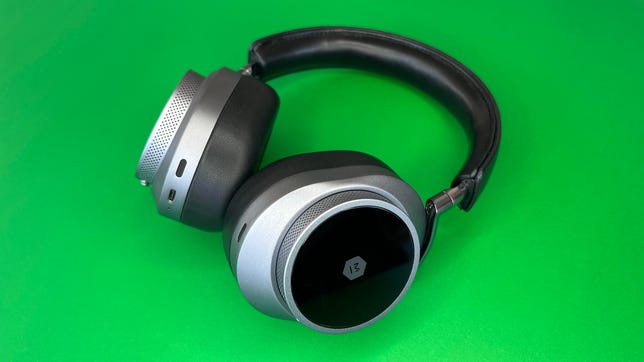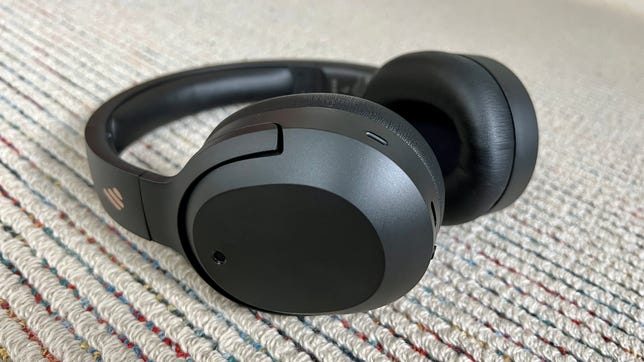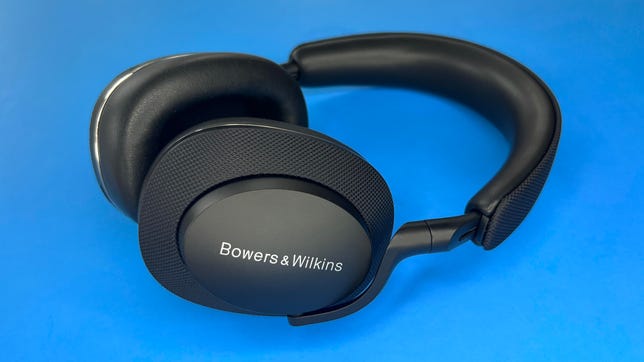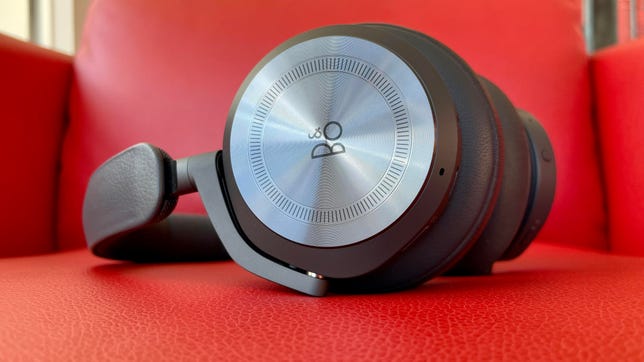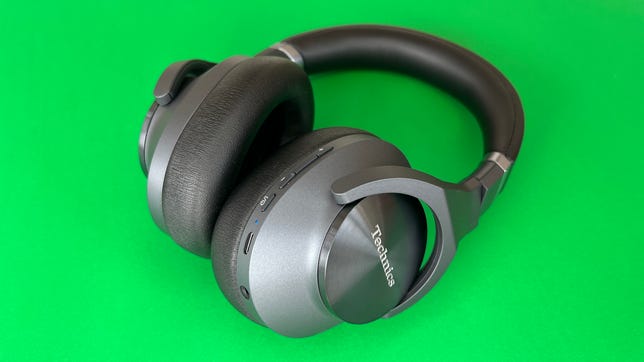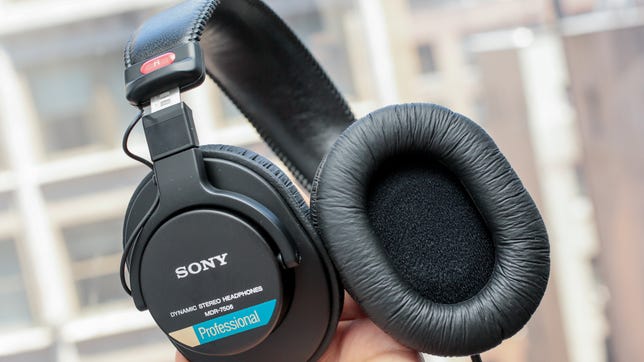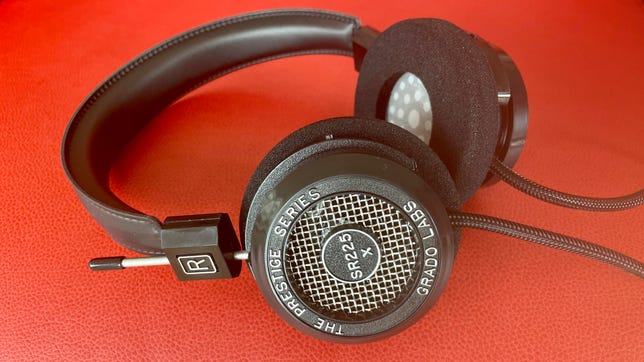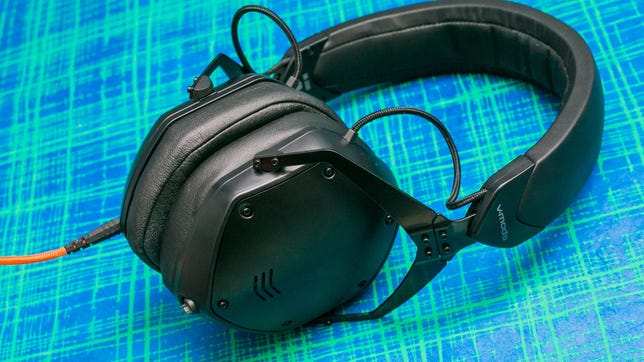While a lot of folks are gravitating toward compact true-wireless earbuds, full-size over-ear or “around-the-ear” headphones remain quite popular. Most of the over-ear headphones on this list are wireless Bluetooth headphones that feature active noise canceling (some but not all wireless headphones also come with a cable for wired listening), but I’ve also included a handful of wired-only over-ear headphones for the audio purists out there looking for great sound.
When selecting the best over-ear headphones for this list, I considered factors such as build quality, comfort and sound quality, as well as noise-canceling and voice-calling performance. This list is regularly updated as more over-ear headphones hit the market. Here’s what I added in my most recent update: the Sennheiser Momentum Wireless 4, Sennheiser 660S2, Sony CH-720N, 1More SonoFlow, Focal Bathys, Bowers & Wilkins PX7 S2 and Master & Dynamic MW75.
What are the best over-ear headphones right now?
There’s a lot of debate around this question, and it’s hard to name one single model as the best overall over-ear headphone. But a few models do stand out a bit from the rest of the pack, including the Sony WH-1000XM5 and Apple’s AirPods Max (for iPhone users). For sound quality in a wireless over-ear headphone, the Focal Bathys are hard to beat, but they cost $799.
Read more: Best Headphones for 2023: Our Top Overall Picks
Best over-ear headphones
Battery Life
Rated up to 20 hours
Noise Canceling
Yes (ANC)
Multipoint
No
Headphone Type
Over-ear wireless headphones
Water-Resistant
No IP rating
Yes, they’re expensive, but the AirPods Max deliver richer, more detailed sound than lower-priced competitors from Bose and Sony. They also feature arguably the best noise cancellation on the market, along with premium build quality and Apple’s virtual surround-sound spatial audio feature for video watching. While they’re heavy, they manage to be surprisingly comfortable, though I did have to adjust the mesh canopy headband to sit a little more forward on my head to get a comfortable secure fit when I was out walking with them. They should fit most heads well, but there will be exceptions.
Battery Life
Rated up to 32 hours
Noise Canceling
Yes (ANC)
Multipoint
Yes
Headphone Type
Over-ear wireless headphones
Water-Resistant
No IP rating
When you have a product that a lot of people love, change can be risky. Such is the case for Sony’s WH-1000XM5, the fifth generation of the 1000X series headphones, which were first released in 2016 as the MDR-1000X Wireless and have become increasingly popular as they’ve improved with each generation. Over the years, Sony has made some tweaks to the design, but nothing as dramatic as what it’s done with the WH-1000XM5. Other than the higher $400 price tag ($50 more than the WH-1000XM4), most of those changes are good, and Sony’s made some dramatic improvements with voice-calling performance as well as even better noise canceling and more refined sound.
You’re receiving price alerts for 1MORE SonoFlow Active Noise Cancelling Headphones, Bluetooth Headphones with LDAC for Hi-Res Wireless Audio, 70H Playtime, Clear Calls, Preset EQ Via App
The design of 1More’s SonoFlow headphones reminds me a little of some earlier Sony headphones and also the newer Sennheiser Momentum Wireless 4. They’re a bit generic looking but sleek enough and more importantly, comfortable to wear. They also feature very respectable sound quality. While it doesn’t quite measure up to the sound quality of what’ll get with more premium models like the Momentum Wireless 4, it isn’t that far off. The SonoFlow headphones deliver smooth sound with good clarity and relatively well-defined bass (they’re just not quite as rich or dynamic sounding as those premium models I mentioned). They also have support for the LDAC audio codec.
The noise canceling is a step down from what Sony and Bose models offer, but it does a decent job of muffling ambient sound and there is a transparency mode. Voice-calling performance is similarly solid but unspectacular. Note that you can use this in wired mode with the included cable but the noise canceling only works in wireless mode, which is an issue for frequent flyers who like some noise canceling when plugging into an in-flight entertainment system.
Sony’s improved entry-level noise canceling headphones, the CH-720Ns, have a bit of a plastic-y budget vibe, but they’re lightweight and very comfortable. Part of me was expecting them to sound pretty mediocre, but I was pleasantly surprised. No, they don’t sound as good as the WH-1000XM5s. But they sound more premium than they look (and feel), and their overall performance is a nice step up from their predecessor, the CH-710Ns. Are they worth $150? Maybe — or maybe not. But the good news is that, like the CH-710N and WH-XB910 before them, these should see some nice discounts in the not-so-distant future, which is what you may want to wait for.
Battery Life
Rated up to 25 hours
Multipoint
Yes
Headphone Type
Over-ear wireless headphones
Water-Resistant
No IP rating
The Bose QuietComfort 45 essentially looks the same as its popular predecessor, the QuietComfort 35 II, with the biggest design difference being a USB-C port in place of the older Micro-USB. (At 238 grams, the QC45 weighs just 3 grams more than the QC35, which should be imperceptible.) And while the Bose 700 has plenty of fans, a lot of people (including me) think this QuietComfort design is slightly more comfortable and the headphones fold up and fold flat. It’s arguably the most comfortable pair of headphones out there.
They also sound very similar to the QC 35 II, with no change to the drivers. Where you’ll see an improvement is with the noise cancellation (there’s a transparency mode), which very well could be the best out right now. According to Bose, there’s a new electronics package that powers the new ANC system, which now better muffles “unwanted sounds in the midrange frequencies” (voices) that you’d “typically find on commuter trains, busy office spaces and cafes.”
I found that to be true and give these the slight edge over both the Headphones 700 and Sony WH-1000XM4 for noise canceling. That said, you can’t adjust the level of noise canceling like you can with those models, which offer a more robust feature set, particularly the Sony. You also can’t tweak the sound in the app; there’s no equalizer settings.
The headset performance has also improved, with better noise reduction during calls. And these offer multipoint Bluetooth pairing. That means you can pair the QC45 with two devices simultaneously — such as a smartphone and PC — and switch audio as needed. They’re equipped with Bluetooth 5.1 and support the widely compatible AAC audio codec but not AptX.
While these have advantages over the Headphones 700 and Sony WH-1000XM4 and do sound quite good, those models sound slightly better: The 700 is slightly more natural sounding and tuned more for audiophiles, while the Sony has more dynamic bass. So that makes choosing between these three models that much more difficult.
Sennheiser’s previous-generation Momentum Wireless headphones have always had a pretty distinct look that was part retro, part modern, and stood out for the exposed metal on their headband. For better or worse, that’s all gone now, and the new Momentum 4 Wireless, Sennheiser’s flagship noise-canceling headphones, look a bit more subdued and also a bit more like some of their competitors.
The Momentum 4 Wireless offers superior performance over the Momentum 3 Wireless in every regard, though the biggest gains are with noise canceling and voice-calling performance as well as battery life, which is outstanding — up to 60 hours at moderate volume levels. There’s also a transparency mode that allows ambient sound in, as well as the ability to create a custom sound profile in the Smart Control app for iOS and Android using the built-in EQ, sound modes and a new Sound Personalization feature that “assesses the user’s listening preferences and adjusts the listening experience according to their taste.”
Equipped with 42mm drivers, Sennheiser says the Momentum 4 Wireless offer “best-in-class” sound, which is debatable. I’d say the Momentum 4’s sound quality is right there with other models in this price range — they sound excellent, with the requisite well-defined, punchy bass, relatively wide soundstage (they sound pretty open) and smooth treble that brings out some of the finer details in well-recorded tracks. They’re a pleasure to listen to.
Battery Life
Rated up to 60 hours
Noise Canceling
Yes (ANC)
Multipoint
Yes
Headphone Type
Over-ear wireless headphones
Water-Resistant
No IP rating
Premium noise-canceling headphones tend to cost more than $300. But what if you’re on a tight budget — what’s your best option for noise-canceling over-ear headphones?
As far as sound, comfort level and build quality, you’d be hard-pressed to do better than Anker’s SoundCore Life Q30 for the money. They don’t quite have the same clarity or bass definition as some of the top premium models, but they’re less than a third of the price and get you about 75% of the way there in terms of sound: It’s well-balanced overall with punchy bass, and there’s an app that allows you to tweak the sound. The noise canceling is good for the price, though not up to the level of the Sony WH-1000XM4 or Bose Noise Cancelling Headphones 700. Battery life is rated at an impressive 40 hours with USB-C charging.
The only area where the Q30 headphones fall a little short is voice calls. They pick up your voice fine in quieter environments, but they just don’t reduce background noise all that well.
Compared with the step-down Q20, the Q30 headphones do offer improved sound (it’s not a huge difference, but it definitely is a notch up) and a more premium design.
Battery Life
NA
Noise Canceling
No
Multipoint
No
Headphone Type
Over-ear wired headphones
Water-Resistant
No IP rating
We were fans of Beyerdynamic’s earlier DT 770 Pro headphones. The new DT 700 X is easier to drive than the 770 Pro, thanks to the company’s new STELLAR.45 sound transducer with an impedance of 48 ohms, so it plays better with smartphones, tablets and laptops without requiring a headphone amp.
The headphone is targeted at content creators who want accurate audio reproduction, but it’s a bit more dynamic sounding and less bass shy than many studio headphones, which tend to restrain the bass and hew toward a very neutral sound profile. The DT 700 X is a revealing, clean-sounding headphone that offers invitingly open sound (particularly for a closed-back headphone) and makes you realize what you’re missing after listening to similarly priced Bluetooth headphones.
Unlike the earlier DT 770 Pro, which is being sold at a nice discount (around $160), the DT 700 X comes with two interchangeable (detachable) straight cables in different lengths, and the DT 700 X arguably has a little cleaner look than its predecessor.
The solidly built headphone — it weighs 350 grams — is quite comfortable, featuring upgraded soft, velour-covered memory foam earpads that offer decent passive noise isolation. The earpads and the headphones’ other parts are replaceable, Beyerdynamic says.
Beyerdynamic also sells the open-back DT 900 X for the same price. That model should provide slightly more open, airy sound but the big drawback is people around you can hear whatever you’re listening to — and sound also leaks in. This closed-back version is more versatile.
French audio company Focal is known for its high-end speakers and headphones. You might call it the Bowers & Wilkins of France. And now it’s finally done what a lot of high-end audio companies have had to do in this age of on-the-go wireless music listening: make active noise-canceling Bluetooth headphones.
Over three years in development, the Bathys cost $799 and feature not only wireless connectivity but a built-in DAC (digital-to-analog converter) for USB wired listening with any computer, smartphone or tablet with USB-C. They are easily one of the best-sounding wireless headphones.
While the Sennheiser 660S2 may seem expensive, it’s one of the more affordable true audiophile headphones, sharing the same design as its predecessor, the 660S. The changes are all on the inside, with improved airflow and upgraded drivers that include a new ultralight aluminum voice coil. This leads to better sound, with the bass adding more depth and definition, while the treble gains a bit more clarity and sizzle (the very natural-sounding mids remain pretty much unchanged as far as I can tell). The soundstage also seems more spacious and airy — yes, these are open-back headphones so they do leak sound.
Note that the 660S2 requires some extra power to drive (it’s now a 300-ohm headphone), so you’ll want to pair it with a dedicated headphone amplifier. I did manage to use it with an iPhone but plugged it into an AudioQuest Dragonfly USB DAC/Amp designed for use with iPhones (there’s also a version for Android smartphones). It sounded great listening to high-resolution tracks from Qobuz, the music streaming service.
Audiophile headphones usually have a very neutral sound profile, but the 660S2 doesn’t suffer from being overly so. It mixes in just enough excitement while also managing to sound really clean and smooth. It’s also a comfortable headphone, though some people with larger heads have complained that it feels a bit too tight on their heads. (I have a more medium-size head and they felt good over long listening sessions.)
The MW75 are Master & Dynamic’s best full-size headphones yet. Needless to say, they’re pricey at $599; most people will be quite satisfied with the $400 Sony WH-1000XM5s, which are lighter and more comfortable, and which deliver best-in-class voice calling and noise canceling. But the MW75’s build quality is hard to beat and they offer top-notch sound for a wireless model (I thought they sounded better than Apple’s AirPods Max headphones), plus strong voice-calling and noise-canceling performance. With their support for aptX Adaptive, they have additional appeal for Android users, who can get a touch better sound quality with the right setup. But I was also quite happy streaming music with my iPhone 13 Pro using the AAC codec.
All of Master & Dynamic’s headphones are well built (they’re sturdy) and have a unique retro-modern look. The higher-end MW75 has active noise canceling and sounds a little better than the freshly updated MH40, which features new drivers and a new chipset that delivers improved sound and performance. But the MH40 sounds more refined than its predecessor, with better clarity and definition, and now offers support for the AAC and AptX audio codecs, plus improved voice-calling performance. Additionally, you can plug its USB-C cable into a computer or Android smartphone for a wired digital connection for high-resolution audio. Battery life is rated at a healthy 30 hours.
To be clear, this isn’t a noise-canceling headphone, but you do get decent passive noise isolation from the nicely padded ear cups, which adhere magnetically and are easy to swap out should they eventually show some wear. Available in several color options, the MH40s are comfortable to wear — they weigh 280 grams — but may not be a good fit for those with smaller heads.
Battery Life
Rated Up to 49 Hours
Noise Canceling
Yes (ANC)
Multipoint
No
Headphone Type
Over-Ear Wireless Headphones
Water-Resistant
No IP Rating
Edifier makes some good-sounding PC speakers and true-wireless earbuds, and it’s done a nice job with its W820NB noise-canceling headphones. The first thing you’ll notice about them when you put them on is that they’re comfortable — the earpads are nicely cushioned and the headphones fit snugly on your head. They also sound good for their price, offering just enough clarity and decent bass performance. Their sound didn’t blow me away, but I was fine listening to these headphones for a while; they sound pretty pleasant.
There’s also an ambient mode that lets outside sound in and a low-latency gaming mode. They’re decent enough for voice calling and battery life is pretty impressive, with up to 49 hours on a single charge at moderate volume levels (and noise canceling off).
A couple of things are missing. There’s no carrying case or headphone jack — they’re Bluetooth only. But the 820NB headphones are still a good value.
Available in three color options (gray, blue and black), Bowers & Wilkins PX7 S2 headphones offer some significant improvements over the first-generation version. Not only are these headphones more comfortable — they tip the scales at 307 grams — but they sound better and have better noise-canceling and voice-calling performance with improved noise reduction. I don’t necessarily think they’re a better option than the lighter and even more comfortable Sony WH-1000XM5. But the PX7 S2 certainly looks and feels luxurious, with its sturdy design, and delivers very good sound with better voice-calling performance thanks to an upgraded microphone setup.
Bowers & Wilkins has also released a step-up model, the PX8, that features even better sound but costs significantly more.
Battery Life
Rated up to 35 hours
Noise Canceling
Yes (ANC)
Multipoint
Yes
Headphone Type
Over-ear wireless headphones
Water-Resistant
No IP rating
Bang & Olufsen’s Beoplay HX headphones are the successor to the company’s H9 series headphones (the X is the Roman numeral 10) and, like those earlier H9 models, the HX headphones carry a list price of $500 (some colors are discounted at Amazon). That price makes it a direct competitor of Apple’s AirPods Max, which are heavier at 385 grams versus the HX’s 285 grams. I don’t know if the HX headphones are more comfortable than the AirPods Max, but I found the two models pretty equal in the comfort department over longer listening sessions, and these do feature the usual swanky B&O lambskin-covered memory foam earpads.
The HX has custom 40mm drivers, Bluetooth 5.1 and support for Qualcomm’s aptX Adaptive (that includes AptX HD) for high-resolution wireless streaming when you combine an aptX-enabled Android device with certain music-streaming services like Qobuz.
Their sound measures up well to the AirPods Max’s sound, overall well-balanced, with deep, well-defined bass, natural-sounding mids (where vocals live) and inviting detail in the treble. If you want to push the treble or bass, you can tweak the EQ in the Bang & Olufsen app for iOS and Android and give the headphones a warmer or brighter profile.
While these are expensive, they offer more accurate sound than the Sony WH-1000XM4. Their noise canceling is also very good and voice-calling capabilities are also quite solid. Additionally, they offer multipoint Bluetooth pairing so you can connect them with a smartphone and PC simultaneously (Microsoft Swift Pair-enabled for Windows machines) so you can easily switch between the two. (The Sony WH-1000XM4 headphones also have this feature.) Battery life is rated at up to 35 hours with noise canceling on and 40 hours with it off. Those are excellent numbers.
Earlier Bang & Olufsen models included a soft case (a pouch really), but the HX headphones come with a hard case. As I said, they’re expensive, but the small improvements over earlier flagship Bang & Olufsen noise-canceling headphones help make the HX headphones a worthy alternative to the AirPods Max.
Battery Life
Rated up to 50 hours
Noise Canceling
Yes (ANC)
Multipoint
Yes
Headphone Type
Over-ear wireless headphones
Water-Resistant
No IP rating
There’s a bit of an old-school vibe to the Technics EAH-A800 — and it’s not just the Technics brand, which Panasonic resurrected in the last few years. Their design is something of a throwback but the headphones are comfortable and both fold up and fold flat. They feature a big, energetic sound with powerful bass and good detail. However, they take a day or two to break in.
They feature ear-detection sensors that automatically pause your music when you take the headphones off, as well as multipoint Bluetooth pairing, so you can connect them to two devices at the same time like a computer and smartphone. Additionally, they have support for Sony’s near lossless LDAC audio codec for Bluetooth streaming that’s available on certain Android devices. I mainly listened to these headphones with an Android device and the Qobuz music service, which offers high-resolution tracks. That setup offers the best possible wireless sound quality.
The headphones are available in black and silver, and according to Panasonic, can deliver up to 50 hours of battery life at moderate volume with ANC on. That’s excellent. The EAH-A800 also works well as a headset for making calls, with eight onboard microphones for noise reduction and voice pickup.
Battery Life
NA
Noise Canceling
No
Headphone Type
Over-ear wired headphones
Water-Resistant
No IP rating
Introduced way back in 1991, the Sony MDR-7506 has long been a favorite headphone of recording engineers and other sound professionals (yes, these are wired headphones). The origins of its design date even further back, since the MDR-7506 headphones are, in fact, a refresh of the Sony MDR-V6 that rolled out in 1985. Both models were designed for the pro sound market, but remain hugely popular with consumers.
While the two models have the same design and are very comfortable, they don’t sound identical. Both offer very well-balanced sound and excellent clarity for their modest prices — and both are great overall values. But the MDR-V6 headphones make a little more bass and sound more laid-back and mellow, while the 7506 headphones are leaner with a more accentuated treble range, which makes the sound a little crisper and livelier.
Battery Life
NA
Noise Canceling
No
Multipoint
No
Headphone Type
Over-ear wired headphones (listed as on-ear)
Water-Resistant
No IP rating
Grado upgraded its entry-level line of Prestige Series wired headphones in 2022. Hand-built, the line includes the SR60x, SR80x, SR125x, SR225x and SR325x, and they’re all very good at their various prices. Arguably, however, the $225 SR225x headphones hit the sweet spot if you’re looking for open-back audiophile-grade headphones that won’t cost you an arm and a leg.
This updated model features a more durable eight-conductor cable infused with “super annealed” copper for “improved purity of the audio signal,” a more comfortable headband design and updated fourth-generation 44mm drivers that further cut down on distortion and are also more energy-efficient, making them easier to drive. I not only used these headphones with an external headphone amplifier attached to my computer but with an iPhone using a Lightning-to-3.5mm adapter. They had plenty of volume when connected directly to the iPhone.
Open-back headphones are supposed to produce more open sound and these do just that, with powerful, controlled bass and natural, warm-sounding mids (where vocals live) along with excellent overall clarity. Stepping up to the SRS325x should give you a little bit more bass energy, but you’re not looking at a big jump in sound quality. As with any open-back headphones, these do leak some sound, so people around you can hear what you’re listening to.
These headphones have semisoft foam earpads that, when you first put them on, you wouldn’t think would be that comfortable over longer listening sessions. But they end up being more comfortable than you’d expect and the new headband design does help in that department. For entry-level audiophile-grade headphones that cost less than $250, it’s hard to do better than the SR225x.
V-Moda’s M-200 is one of the few wired headphones on this list. Released in late 2019, these clean and detailed sounding over-ear headphones have excellent bass response, and the cushy earcups mean they’re also comfortable to wear. Featuring 50mm drivers with neodymium magnets, CCAW voice coils and fine-tuning by Roland engineers — yes, V-Moda is now owned by Roland — the M‑200 is Hi‑Res Audio-certified by the Japan Audio Society. Other V-Moda headphones tend to push the bass a little, but this set has the more neutral profile that you’d expect from studio monitor headphones. They come with two cords, one of which has a built-in microphone for making calls. It would be nice if V-Moda offered Lightning or USB-C cables for phones without headphone jacks.
Note that last year V-Moda released the M-200 ANC ($500), a wireless version of these headphones that includes active noise canceling. They also sound great, but their noise cancellation, call quality and overall feature set don’t match those of the AirPods Max.
Is it ‘noise canceling’ or ‘noise cancelling’?
Short answer: both. Either spelling is correct, as “canceling” is more common in American English, while “cancelling” is more common in British English. CNET uses “noise canceling” since the company is based in the US, but the noise is canceled just the same, regardless of spelling. If you’re looking to see what different noise-impacting technology is out there for headphones, check out our article on noise-canceling versus noise-isolating headphones, which highlights differences in function (and not just a difference in spelling).
